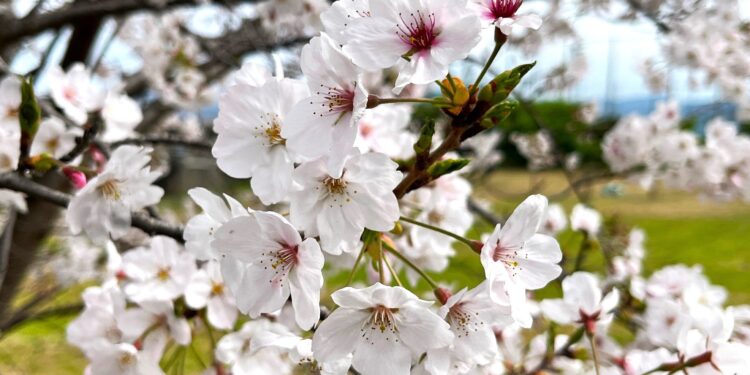Somei Yoshino cherry blossoms at Ito Campus, Kyushu University. Credit: Atsuko Miyawaki-Kuwakado, Kyushu University
In spring, Japan is famous for its cherry blossoms, or sakura, which begin blooming in the southern region of Kyushu and spread as far north as remote Hokkaido. The most abundant cherry cultivar, Somei Yoshino, is an iconic symbol of spring, as cloned trees bloom simultaneously at each site, creating a fleeting explosion of white-pink flowers that enchants locals and tourists alike.
The Somei Yoshino cherry blossom forecast is made several months in advance of the bloom, as visitors plan their trips and locals hold festivals and celebrations. However, due to climate change, the blooming times of these cherry trees are shifting and becoming more difficult to predict.
Researchers from Kyushu University and the Forestry and Forest Products Research Institute have now developed a model that uses genetic activity to predict when Somei Yoshino cherry buds awaken from dormancy.
Their conclusions, published on September 19 in the journal Plants, Men, Planetcould not only help improve the accuracy of flowering forecasts, but also highlight the potential for climate change to threaten flowering in the southern region of Japan.
Before cherry trees can bloom, the buds must go through two phases of dormancy, endodormancy and ecodormancy. A period of sufficiently cool temperatures during the winter is necessary to break endodormancy, while exit from ecodormancy requires an input of warmth in the spring.
“This need for cooling and heating means that flowering times can be very unpredictable,” says first author Atsuko Miyawaki-Kuwakado, a researcher at JSPS in the Faculty of Science at Kyushu University. “Depending on the temperature in autumn, winter and spring, flowering can be early, delayed or completely prevented.”
When ecodormancy is broken, buds quickly begin to grow and open. But it is difficult to know when the previous stage of endodormancy was broken, because the buds show no noticeable changes. However, Miyawaki-Kuwakado and lead author Professor Akiko Satake of the Faculty of Science at Kyushu University speculated that studying the inner workings of the bud could reveal the timing of this key moment.
DAM4 expression levels decline throughout the winter, with each day falling below 10.1°C. After approximately 61 days, DAM4 The activity is low enough that endodormancy is disrupted. Credit: Atsuko Miyawaki-Kuwakado, Kyushu University
Starting in October, the researchers took monthly samples of leaves and buds from Yoshino cherry trees at three sites across Japan: Fukuoka in the south, Tsukuba in the center, and Hokkaido in the north, capturing a snapshot of which genes were most active at each time.
The researchers found that Yoshino cherry buds typically went through five main patterns of gene activity, in early summer, summer, autumn, winter and spring, with each activity pattern closely related to temperature.
The research team then focused on the activity, or expression levels, of a subset of genes, called DAMs, that are associated with bud dormancy. Of the six DAM genes, the researchers found that DAM4 activity played a key role in maintaining endodormancy.
“We found that in early winter, DAM4 was highly expressed, but as each day passed with temperatures below 10.1°C, DAM4 activity decreased. Once below a certain threshold, buds woke up from dormancy and flowered when experimentally heated,” Satake says.
Using a model based on DAM4 activity, the researchers concluded that Yoshino cherry trees require about 61 days with temperatures below 10.1 °C for endodormancy to break. Using historical temperature data from the Japan Meteorological Agency, the team then estimated that between 1990 and 2020, endodormancy breaking was delayed by 2.3 days per decade.
In the future, forecasters could use the estimated wake times to improve their predictions of when Yoshino cherry blossoms will bloom. The researchers also plan to refine the model to predict how climate change will impact flowering.
“Without enough cool days in winter, endodormancy cannot break and Yoshino buds cannot bloom,” Miyawaki-Kuwakado says. “So it is important to predict the impact of global warming, especially in the southern region of Japan, so that we can try to develop strategies to mitigate it.”
More information:
Impacts of climate change on transcriptional dynamics and timing of bud dormancy breaking in Yoshino cherry, Plants, Men, Planet (2024). DOI: 10.1002/ppp3.10548
Provided by Kyushu University
Quote:Genetic model predicts when Japanese cherry buds will awaken from dormancy (September 19, 2024) retrieved September 19, 2024 from
This document is subject to copyright. Apart from any fair dealing for the purpose of private study or research, no part may be reproduced without written permission. The content is provided for informational purposes only.



